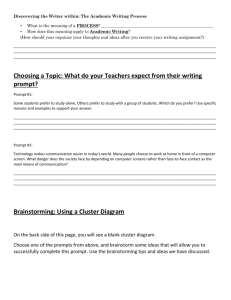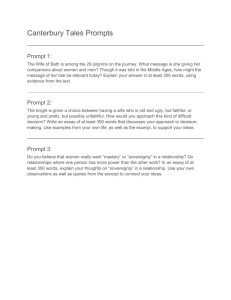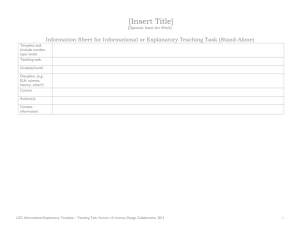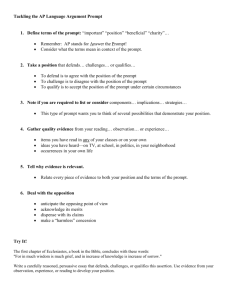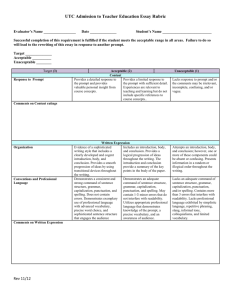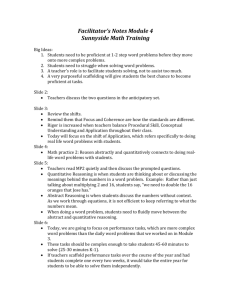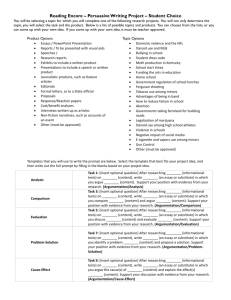Mammal Respiration Report
advertisement
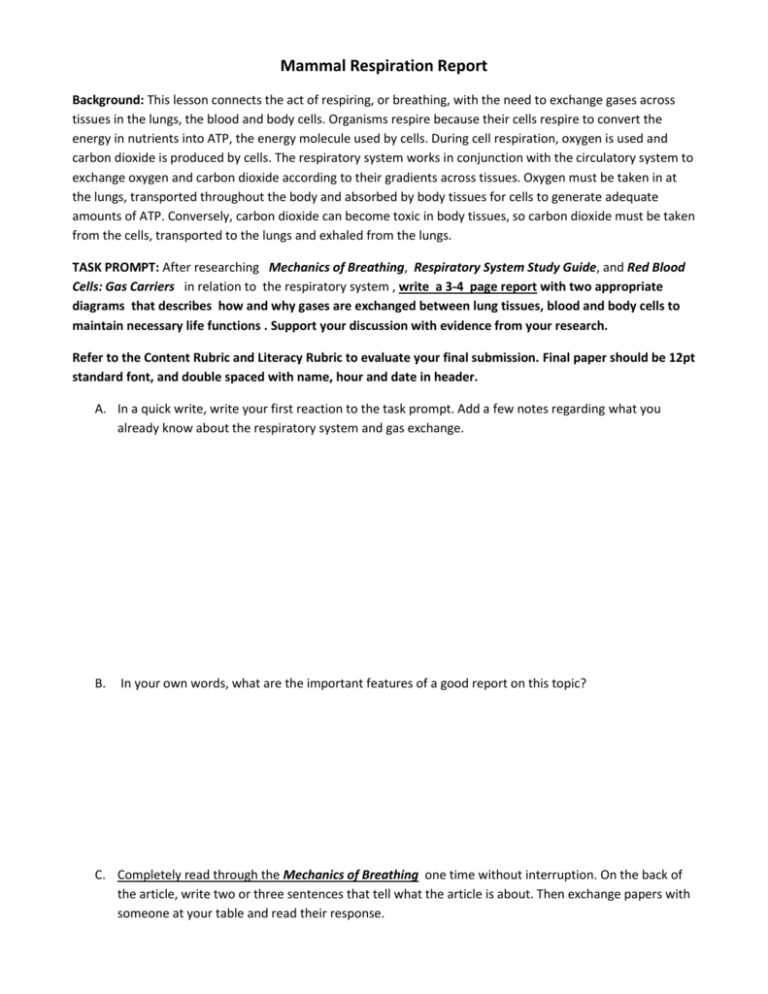
Mammal Respiration Report Background: This lesson connects the act of respiring, or breathing, with the need to exchange gases across tissues in the lungs, the blood and body cells. Organisms respire because their cells respire to convert the energy in nutrients into ATP, the energy molecule used by cells. During cell respiration, oxygen is used and carbon dioxide is produced by cells. The respiratory system works in conjunction with the circulatory system to exchange oxygen and carbon dioxide according to their gradients across tissues. Oxygen must be taken in at the lungs, transported throughout the body and absorbed by body tissues for cells to generate adequate amounts of ATP. Conversely, carbon dioxide can become toxic in body tissues, so carbon dioxide must be taken from the cells, transported to the lungs and exhaled from the lungs. TASK PROMPT: After researching Mechanics of Breathing, Respiratory System Study Guide, and Red Blood Cells: Gas Carriers in relation to the respiratory system , write a 3-4 page report with two appropriate diagrams that describes how and why gases are exchanged between lung tissues, blood and body cells to maintain necessary life functions . Support your discussion with evidence from your research. Refer to the Content Rubric and Literacy Rubric to evaluate your final submission. Final paper should be 12pt standard font, and double spaced with name, hour and date in header. A. In a quick write, write your first reaction to the task prompt. Add a few notes regarding what you already know about the respiratory system and gas exchange. B. In your own words, what are the important features of a good report on this topic? C. Completely read through the Mechanics of Breathing one time without interruption. On the back of the article, write two or three sentences that tell what the article is about. Then exchange papers with someone at your table and read their response. D. Identify important vocabulary i. On a separate sheet of paper list the bolded words from the Mechanics of Breathing and write a brief definition in your own words for each. E. Study Lungs at National Geographic website: http://science.nationalgeographic.com/science/healthand-human-body/human-body/lungs-article/ i. Click through Lung Anatomy links in the lower left including alveoli. Read the captions! ii. Choose Lung Functions and follow the prompts (click on directions or “continue”) to see the lungs operate. B. Build model lungs in class – write a brief paragraph explaining how air is inhaled and exhaled using proper anatomy terms. F. Read the remaining articles, Respiratory System Study Guide, and Red Blood Cells: Gas CarriersWrite a couple of sentences at the bottom of each article stating what the article is about. G. Watch video at RBC video http://education-portal.com/academy/lesson/circulatory-system-iv-redblood-cells.html H. Take notes from each text. i. From each text, write elements or phrases that look most important for answering the prompt on a separate notecard. ii. Avoid plagiarism by using your own words and keeping track of the source of each piece of information. (assign a number, color, or shorthand to each article on the notecards) I. Organize note cards. i. Write the following headings on four note cards: 1) What is respiration and why is it necessary; 2) how air is moved in and out of the body; 3) how gases are exchanged in the lungs; 4) how gases are exchanged in the body tissues. ii. Combine and organize your research note cards into four rows (a row under each topic). iii. Examine someone else's note card rows as they examine yours. iv. Discuss any significant differences in organization between the two of you. Each of you should be able to explain why you placed an idea under a particular heading. J. Create an outline based on your organized note cards in which you state your main point about the function of respiratory systems and sequence your subtopics with evidence from the texts. Print a copy of your outline for your project submission. K. Write an initial draft complete with opening, development, and closing. Choose two illustrations that clearly enhance the material of your report . Print a copy of your initial draft for later submission. L. Write a second draft i. Refine composition’s analysis, logic, and organization of ideas/points. Decide what to include and what not to include. Review illustration use and placement to ensure it is well-connected to the content of your paper. ii. Print a copy of this draft for peer review AND later submission. iii. Each person should review one other student's work using circles to highlight where corrections needed and a constructive written comment at the bottom or on the back with your name. M. Write Final Paper - Check final details. Ensure you have sound spelling, capitalization, punctuation, and grammar and adjust formatting as needed to provide clear, appealing text. Turn in your vocabulary list, notecards, outline and complete set of drafts, plus the final version of your report. RESPIRATORY GRADING RUBRICS Final Report Content 50% 2 3 Information presented is accurate, factual, and relevant to the specific topic Most Information inaccurate or irrelevant 1 Some information inaccurate or irrelevant One or two minor factual errors No factual errors 4 The purpose and function of the respiratory system is clear. Air movement is thoroughly explained using proper anatomical terms Gas exchange and gas transport are described, related to gradients and life processes Very unclear whether addressed Not well explained or terms lacking or misused Not well described and not related to life processes Somewhat clear Mostly clear Explanation unclear or few terms Description unclear or not related explanation and terms used solid Good description and relations Clear and thorough Exceeds expectation Two illustrations are logically integrated into the report and well- connected to content. Only one illustration Two illustrations, but illogical Solid illustration selection Excellent description and wellrelated Exceptional integration of illustration Development Process 20% 1 All required process materials submitted Many elements missing or poorly done 2 3 2 elements missing or poorly done Final Report Literacy and Language Skills 30% Scoring Not Yet Approaches Elements Expectations 1 1.5 2 Focus Attempts to address prompt, but lacks focus or is off-task. Addresses prompt appropriately, but with a weak or uneven focus. Controlling Idea Attempts to establish a controlling idea, but lacks a clear purpose. Establishes a controlling idea with a general purpose. Reading/Research Attempts to present information in response to the prompt, but lacks connections or relevance to the purpose of the prompt. Presents information from reading materials relevant to the purpose of the prompt with minor lapses in accuracy or completeness. 1 element missing or poorly done 4 All elements present and well-done Meets Expectations 2.5 3 3.5 Advanced Addresses prompt appropriately and maintains a clear, steady focus. Establishes a controlling idea with a clear purpose maintained throughout the response. Presents information from reading materials relevant to the prompt with accuracy and sufficient detail. Addresses all aspects of prompt appropriately and maintains a strongly developed focus. Establishes a strong controlling idea with a clear purpose maintained throughout the response. Accurately presents information relevant to all parts of the prompt with effective selection of sources and details from reading materials. 4 Development Organization Attempts to provide details in response to the prompt, including retelling, but lacks sufficient development or relevancy. Attempts to organize ideas, but lacks control of structure. Conventions Attempts to demonstrate standard English conventions, but lacks cohesion and control of grammar, usage, and mechanics. Content Understanding Attempts to include disciplinary content in explanations, but understanding of content is weak; content is irrelevant, inappropriate, or inaccurate. Presents appropriate details to support the focus and controlling idea. Presents appropriate and sufficient details to support the focus and controlling idea. Presents thorough and detailed information to strongly support the focus and controlling idea. Uses an appropriate organizational structure to address the specific requirements of the prompt, with some lapses in coherence or awkward use of the organizational structure. Demonstrates an uneven command of standard English conventions and cohesion. Uses language and tone with some inaccurate, inappropriate, or uneven features. Maintains an appropriate organizational structure to address the specific requirements of the prompt. Maintains an organizational structure that intentionally and effectively enhances the presentation of information as required by the specific prompt. Demonstrates a command of standard English conventions and cohesion, with few errors. Response includes language and tone appropriate to the audience, purpose, and specific requirements of the prompt. Accurately presents disciplinary content relevant to the prompt with sufficient explanations that demonstrate understanding. Demonstrates and maintains a welldeveloped command of standard English conventions and cohesion, with few errors. Response includes language and tone consistently appropriate to the audience, purpose, and specific requirements of the prompt.. Briefly notes disciplinary content relevant to the prompt; shows basic or uneven understanding of content; minor errors in explanation. Integrates relevant and accurate disciplinary content with thorough explanations that demonstrate indepth understanding.
